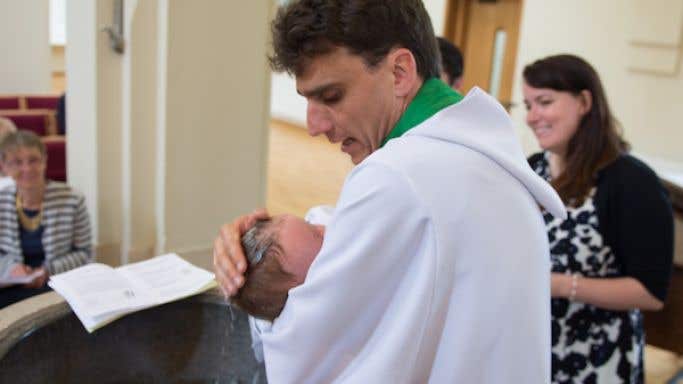Today, since Jancis is taking a four-week break from her Saturday FT slot, we publish the first of the selected entries in our seminal wine competition in which we invited wine enthusiasts to describe the wine or wine experience that lit the flame for them. We are publishing the best of the many entries we have been delighted to receive, and have been very impressed by the overall standard. We have, however, decided not to edit the texts or biographies to conform with our house style, and not to correct any mis-spellings or grammatical mistakes. This should mean that everyone is competing on a level playing field. Look out for many more entries to follow.
Robert Stanier, whose entry appears below, was ordained in the Church of England in 2006 and is now the vicar of St Andrew and St Mark, Surbiton. He is married with three young children, who, he writes, 'unsurprisingly find the subject of wine very boring'.
It was not Lafite; I wanted it to be, but it was not. It was not even Pontet Canet, though its Old World credentials were impeccable.
The location was an Oxford College (Magdalen if you really want to know), in the Nineties. We had just taken our final examinations in Literae Humaniores, the most ancient of the Oxford degrees. The papers themselves are a throw-back from the ages: a series of fearsome translations and then three-hour essay papers on the classical world; if I had had sat them in 1855, the questions might have been the same: they studied Thucydides, Plato and Tacitus then; they do so today. Classics at Oxford barely changes.
The tradition of the ‘Finals Dinner’ feels like it goes back to the ages too. As a kind of reward for our efforts and a farewell to our years of study, the tutors in ancient history, literature and philosophy invite that year’s undergraduate finalists to a special dinner at High Table, with a bespoke menu with various wines, in an evening that rolls on and on and finishes with vintage port at midnight.
The epiphany, though, came with the roast beef. The red that accompanied it was just gorgeous, so much rounder and fuller than anything I had drunk before. I rolled it around my mouth and thought: yes, this is the reason people talk about wine; this, this is just magic; this has a depth I did not imagine possible.
Gradually after the university years, I started getting into the whole world of wine: visiting cellars in Burgundy, tramping through vineyards in the Languedoc, buying a subscription to jancisrobinson.com... but I knew the starting point was that Finals Dinner and the wine I drank then, a voluptuous taste delight. Frustratingly, I also knew that I would never know what it was. These days, I have the wine nerd’s tendency to grab a scrap of paper for a particularly good wine and write a tasting note: I have a decade’s worth of such bits and bobs in a drawer, but from back then? Nothing at all.
However, clearing out the house a few years ago, I picked up an old scrap book, and in the scrap book I stumbled on the menu of that finals dinner in 1998.
“Candidates are expected to take both courses – food and drink...”; the ancient history tutor had put in effort and humour and laid out the menu in the style of an exam paper. It was a nice touch, but I was not interested at this point; I was hunting after the source of my wine fixation, the source of my particular vinous Nile.
By now I had spent years recalling this wine, and it had crossed my mind to consider what it might have been. And here is my confession: I wanted the thing that seared into my taste memory to have been a legend, something upon which I could congratulate myself for having discerned, even with untutored taste buds. I wanted it to be Lafite. The situation made it plausible: Oxford college cellars are awash with fabulous claret bought en primeur in the days of pounds, shillings and pence. My imagination had free rein: if not Lafite, perhaps Haut Brion as had once intrigued Samuel Pepys, or, given that I remembered a big wine, a Hermitage from the northern Rhone? I thought I would never know, but I envisaged something with the pedigree of a thoroughbred stallion.
I turned the menu over to see the wine list: so what was the answer?
Qupé Syrah, Bien Nacido, Santa Maria Valley, California (vintage unspecified.)
I will admit to being disappointed; this did not fit my classically trained hope or expectation. It is not one to write a story about, really. The Syrah from Qupé is not one of the great wines of the world, though, to put it in context, in those student days, when my comparison point was the £3.99 Bulgarian merlot from Bottom’s Up, it is no wonder this stood out like a beacon.
Yet I have matured a little since that initial disappointment. Actually, Qupé is a fabulous winery; their Syrah is a beautiful wine. Moreover, it offered me a way in, that perhaps Haut Brion would not have done; fine clarets can be unobtrusive, for all their elegance. It also says something about how the Magdalen wine steward’s buying policy was more progressive back in the 1990s than you might have suspected.
But to catch the wonder, you also have to catch the occasion; the dinner was the last gasp of a university world in which I had had a brilliant time, drunk on the classics, having made friends for life. Wine, people, food and occasion; it welded into one. It was not Lafite and it was not Haut Brion; it was the Qupé Syrah: it is still my seminal wine moment, and I loved it.
